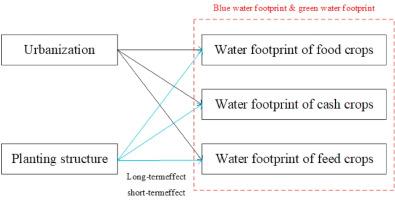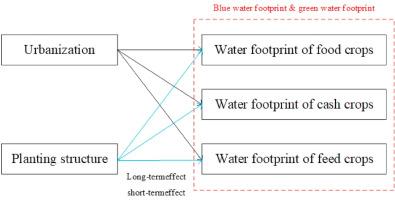Impact of urbanization and planting structure on water footprint of food, cash, and feed crops in China's northern agro-pastoral ecotone
IF 9.7
1区 环境科学与生态学
Q1 ENGINEERING, ENVIRONMENTAL
引用次数: 0
Abstract
China, especially the northern agro-pastoral ecotone, is facing severe water scarcity, which presents a significant challenge for the agriculture sector, the largest consumer of water. This study selected Yanchi County as a typical area. First, the water footprint method is used to evaluate the water usage of food, cash, and feed crops in the region from 1990 to 2020. Then, the vector error correction model (VECM) is used to analyze the short-term effects and long-term effects of urbanization and planting structure on the water consumption of these three types of crops. The results show: 1) The total agricultural water footprint (WF) in Yanchi County, as well as the WFs of the predominantly grown food and feed crops, show an upward trend. Additionally, the proportion of blue WF is relatively high across all crop types. 2) Reducing the proportion of food crops will increase the WF of cash and feed crops, but it will not necessarily decrease the WF of food crops. 3) An increase in the level of urbanization may reduce the agricultural WF in the short term, but ultimately, it will lead to an increase in the WF. Overall, this study reveals the growing pressure on agricultural water use faced by the agro-pastoral ecotone during the processes of urbanization and planting structure transformation. It highlights the importance of developing rain-fed agriculture, seizing the technological development opportunities brought by urbanization, and reasonably adjusting the cropping structure for the sustainable use of water resources.


城市化和种植结构对中国北方农牧生态区粮食、经济作物和饲料作物水足迹的影响
中国,尤其是北方农牧生态区,正面临着严重的缺水问题,这给用水量最大的农业部门带来了巨大挑战。本研究选择盐池县作为典型地区。首先,采用水足迹法对该地区 1990 年至 2020 年粮食、经济和饲料作物的用水量进行了评估。然后,利用向量误差修正模型(VECM)分析了城市化和种植结构对这三类作物用水量的短期影响和长期影响。结果显示1)盐池县农业总水足迹(WF)以及主要种植的粮食和饲料作物的水足迹均呈上升趋势。此外,在所有作物类型中,蓝色水足迹的比例相对较高。2) 降低粮食作物的种植比例会提高经济作物和饲料作物的耕地面积,但不一定会降低粮食作物的耕地面积。3)城市化水平的提高可能会在短期内降低农业用水的可用水量,但最终会导致可用水量的增加。总之,本研究揭示了农牧生态区在城市化和种植结构转型过程中所面临的日益增长的农业用水压力。它强调了发展雨养农业、抓住城市化带来的技术发展机遇、合理调整种植结构对水资源可持续利用的重要性。
本文章由计算机程序翻译,如有差异,请以英文原文为准。
求助全文
约1分钟内获得全文
求助全文
来源期刊

Journal of Cleaner Production
环境科学-工程:环境
CiteScore
20.40
自引率
9.00%
发文量
4720
审稿时长
111 days
期刊介绍:
The Journal of Cleaner Production is an international, transdisciplinary journal that addresses and discusses theoretical and practical Cleaner Production, Environmental, and Sustainability issues. It aims to help societies become more sustainable by focusing on the concept of 'Cleaner Production', which aims at preventing waste production and increasing efficiencies in energy, water, resources, and human capital use. The journal serves as a platform for corporations, governments, education institutions, regions, and societies to engage in discussions and research related to Cleaner Production, environmental, and sustainability practices.
 求助内容:
求助内容: 应助结果提醒方式:
应助结果提醒方式:


